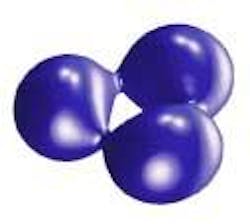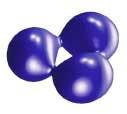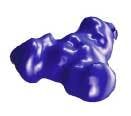Laser beam condensed state resembles liquid
One cannot drink it, but an understanding of "liquid" light may someday lead to ultrafast optical computers. That's the claim of professor of optics Humberto Michinel and colleagues at the Universidade de Vigo (Ourense, Spain), the Universidad de Santiago (Santiago, Spain), and Chalmers University of Technology (Goteborg, Sweden).1 The scientists propagated a laser beam through a special type of crystal and found that, for a given power, the beam reached a condensed state with collisional dynamics that resembles a liquid drop.
A laser beam is analogous to a gas made of photons, says Michinel. Using this analogy, a laser beam directed into a nonlinear optical material called a cubic-quintic optical material causes photons to interact with other photons in unusual ways. In numerical simulations, the photons condense, display surface tension, and sustain vortices, all properties of liquid droplets (see figure). Using a standard Fourier beam propagation with a 1024-point grid, the simulations show internal reflection in a cubic-quintic material surrounded by air. In the calculations, the beam is 25-µm wide and its peak intensity is 2.0 GW/cm2. When the beam reaches the planar interface between the nonlinear material and air, the results resemble a liquid drop hitting a wall and scattering into smaller droplets.
Creating droplets
Producing liquid light in the lab requires a high-power laser of 1-GW peak power and a nonlinear optical material with so-called cubic-quintic nonlinearity. Ultimately, as more powerful continuous-wave lasers become available, continuous light streams will be possible, says Michilen. Continuous-wave lasers do not provide high-enough power to cause the effects. Pulsed lasers, however, can provide the high power, producing light "droplets."
The analogy with light and liquid can be explained as a balance of radiation pressure inside and outside the beam. The refractive index inside the beam is higher than outside, because of the nonlinear effects, says the team. Whereas forces between low-energy photons in a vacuum are negligible, in a nonlinear optical material, photons are exposed to the dielectric effect. The nonlinearity is responsible for the attractive or repulsive forces between pairs of photons.
"This result is a fundamental test of the properties of liquid light as a quantum fluid," says Michinel. As in the case of superfluid helium or Bose-Eintein condensates, liquid light can produce eternal vortices. "We are dealing with a new state of matter with the same properties of quantum fluids," he says.
Michinel thinks the numerical results will start the race to achieve liquid light, the lowest density liquid ever produced. Further, he says the generation of vortices in liquid light may enable generation of all-optical black holes in the lab, helping astronomers understand the physics of black holes.
Liquid light drops can be applied in the design of optical computers for use as bits of robust information that are difficult to break. Logic gates can be designed based on the properties of how light drops collide. Further research is needed, however, to fully understand the phenomenon, including the quantitative determination of the temperature and entropy of the beams for a given nonlinearity.
Reference
- H. Michinel et al., Phys. Rev. E., 65, 066604 (June 2002).




